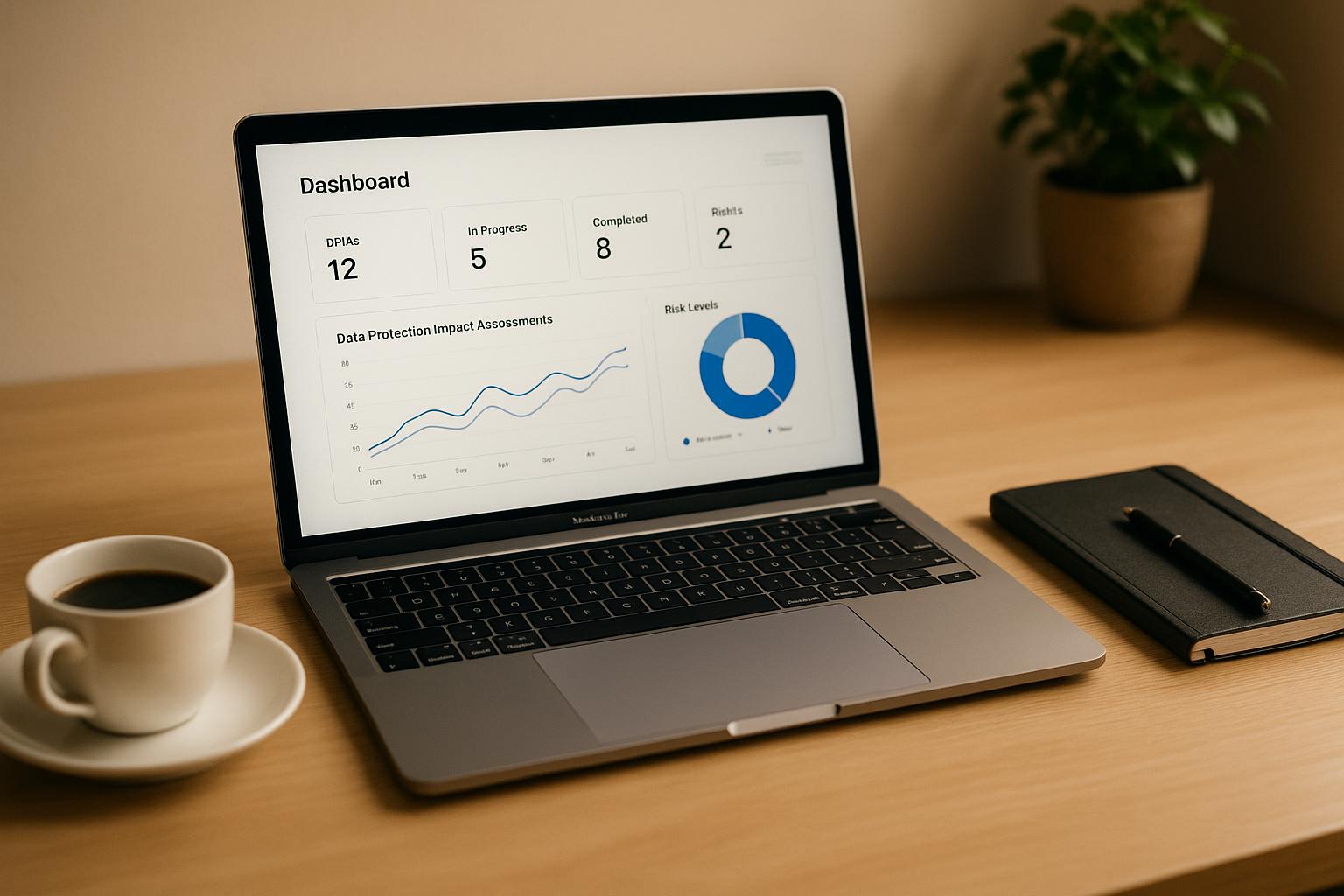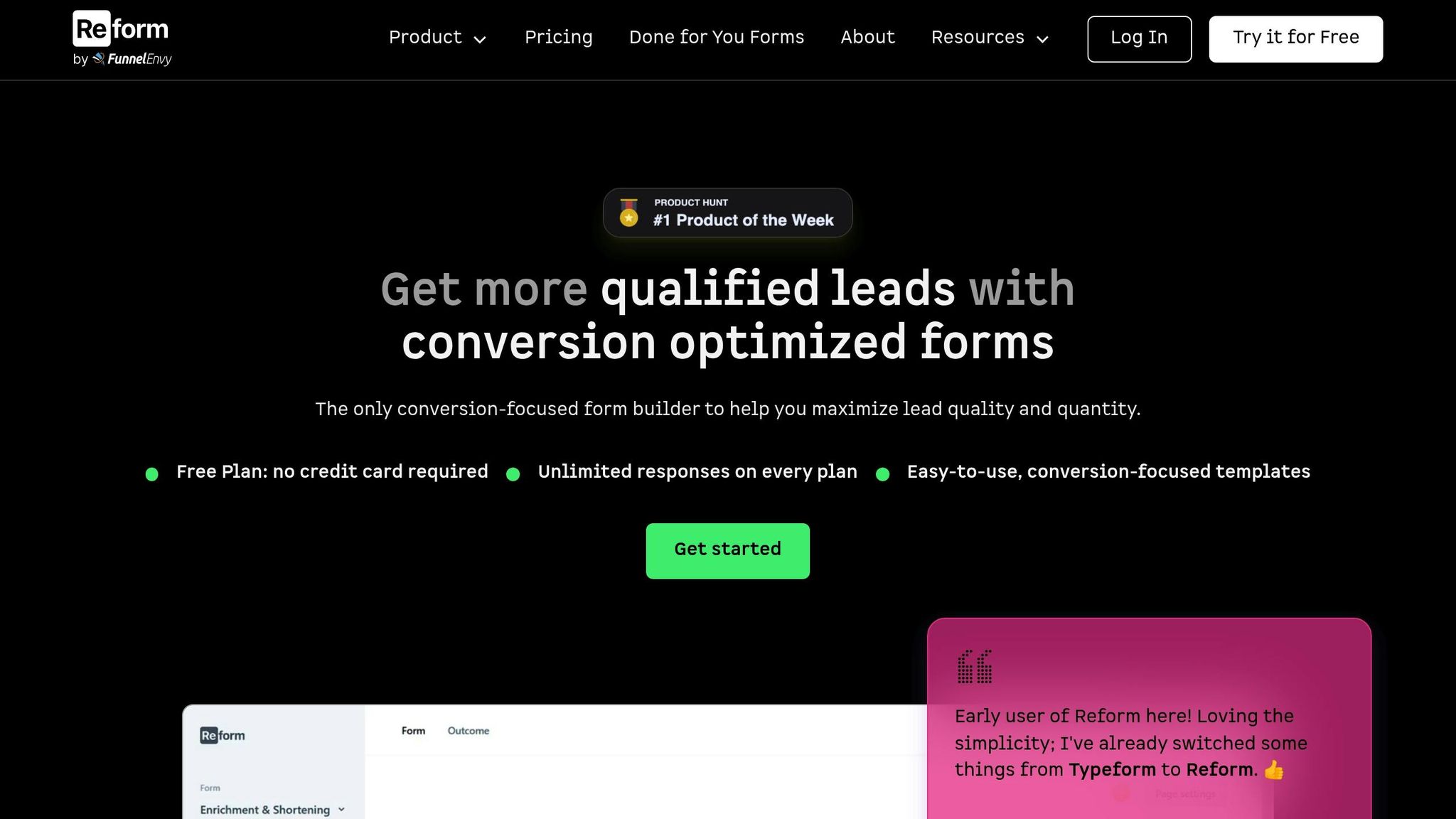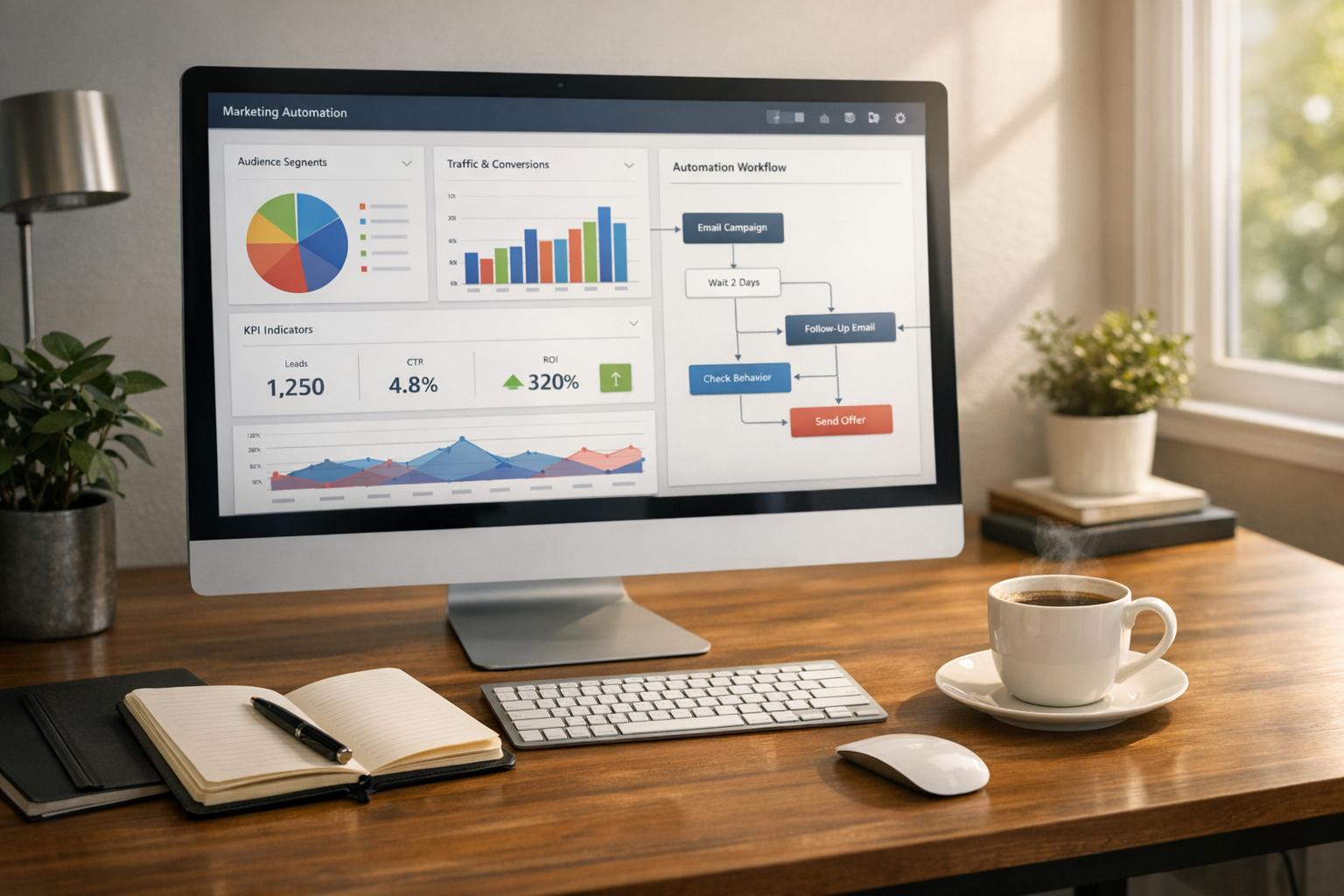5 Steps to Monitor DPIAs Regularly

Monitoring Data Protection Impact Assessments (DPIAs) is not a one-time task. Regular reviews are essential to ensure compliance with evolving regulations like GDPR and CCPA, avoid fines, and minimize privacy risks. Neglecting updates can lead to security vulnerabilities, reputational harm, and financial penalties.
To keep your DPIAs current and effective, follow these five steps:
- Set a Review Schedule: Plan reviews annually or more frequently if handling high-risk data.
- Track Data Changes: Monitor updates in data processing activities to adjust DPIAs accordingly.
- Address New Risks: Stay informed about privacy laws and emerging technologies to identify potential risks.
- Update Controls and Records: Test and refine risk controls, and document changes thoroughly.
- Engage Stakeholders: Collaborate with teams like IT, legal, and compliance to maintain accountability.
Automation tools, like Reform, can simplify this process by streamlining workflows, tracking updates, and ensuring compliance. Regular monitoring not only protects your organization but also builds trust with stakeholders.
Data Protection Impact Assessments (DPIA): Key Steps and Best Practices for Privacy Compliance
Step 1: Set Up a Regular Review Schedule
Having a structured schedule for reviewing your Data Protection Impact Assessments (DPIAs) is key to staying ahead of potential issues. Without a clear timeline, reviews often get pushed back until a problem - like a compliance failure or a security breach - forces action. A proactive review process helps you identify and fix potential issues before they escalate, ensuring your DPIAs remain relevant and adapt to changes in your business.
Set the Review Frequency
How often you review your DPIAs depends on a mix of regulatory requirements and your organization's risk level. For many businesses, annual reviews are the norm. However, if your organization handles high-risk data or operates in a fast-changing environment, more frequent reviews might be necessary.
For instance, the California Privacy Rights Act (CPRA) mandates annual DPIAs for businesses that pose risks to customer data. As stated in the guidelines:
"Businesses should conduct a Data Protection Impact Assessment (DPIA) on an annual basis."
Additionally, the Article 29 Working Party advises reassessing DPIAs every three years - or sooner if there are significant changes in how data is handled. If your organization is growing quickly or introducing new data processes, you should consider shorter review intervals.
Failing to review DPIAs regularly can lead to serious consequences. Take the example of SunnyTech, which launched an app that collected consumer data without conducting a DPIA. This oversight resulted in a data breach, leading to fines ranging from $2,500 per violation to $7,500 for intentional violations.
Assign Roles and Responsibilities
Clear accountability is essential for conducting regular and effective DPIA reviews. Start by designating a specific individual - often a project lead or manager - as the DPIA owner. This person will oversee the process and ensure that reviews result in actionable improvements.
Your Data Protection Officer (DPO) should also play a central role in this process. The DPO provides guidance on compliance, identifies risks, and serves as a point of contact for regulators, stakeholders, and individuals with DPIA-related questions. Early involvement of the DPO ensures a stronger focus on compliance and risk management.
Collaboration is another critical element. The DPO should work closely with stakeholders across IT, legal, and business units to ensure the DPIA is thorough and effective. While the responsibility for carrying out DPIAs ultimately falls on the data controller, tasks can be delegated within the organization or to external parties. Just make sure these delegations are clearly documented.
Engaging a broad range of internal stakeholders during the review process can help uncover risks that might not be obvious at higher levels of management. Additionally, seeking input from data subjects or their representatives can reveal privacy concerns that might otherwise go unnoticed.
To maintain transparency and accountability, document all role assignments and consultation efforts. Keep detailed records of the entire DPIA process, including the scope of the assessment, data mapping, risk evaluations, and management strategies. These records not only demonstrate compliance but also provide an audit trail for future reviews. Consider using a tracking system to monitor review progress and ensure follow-up actions are completed. Assigning clear roles and maintaining thorough records create a strong foundation for keeping your DPIAs up-to-date and effective.
Step 2: Monitor Changes in Data Processing Activities
Data processing within your organization is never static. New software gets introduced, workflows evolve, and teams adopt different methods for handling data. These shifts can render your original Data Protection Impact Assessment (DPIA) outdated or incomplete. The General Data Protection Regulation (GDPR) acknowledges this dynamic nature, emphasizing that DPIAs should be regularly reviewed and updated whenever there are substantial changes to the nature, scope, context, or purposes of data processing.
These changes can unfold in different ways. Sometimes they’re gradual - like adding a new feature to your customer portal or collecting additional data points for marketing. Other times, they’re more sweeping - such as implementing a new CRM system or expanding operations internationally. Regardless of how quickly these changes occur, identifying them early is crucial to avoid compliance issues.
Delaying updates until your next scheduled DPIA review could leave you exposed, especially under regulations that require immediate updates following major changes. This is where technology can play a key role in tracking and managing these changes effectively.
Use Change Monitoring Tools
Automating the monitoring of data processing activities can save time and reduce the risk of missing critical updates. One effective approach is Change Data Capture (CDC), a method that tracks changes in data across various sources to ensure consistency and accuracy. CDC works by identifying modifications - such as insertions, updates, or deletions - in the source database.
Here are three common CDC methods to consider, depending on your specific needs:
| Method | How It Works | Best For |
|---|---|---|
| Log-based CDC | Monitors database transaction logs to detect changes with minimal performance impact | High-volume environments where performance is critical |
| Trigger-based CDC | Uses database triggers to log changes in a dedicated table, though it can increase database overhead | Smaller databases requiring detailed tracking |
| Timestamp-based CDC | Relies on timestamp columns to identify recent changes but may miss updates between scans | Simpler setups with predictable update patterns |
Beyond database changes, it’s essential to analyze logs from data pipelines and error logging tables to spot shifts in how data moves through your systems. This broader perspective helps you identify changes in processing workflows, not just the data being stored.
Organizations can leverage tools provided by database platforms or third-party solutions to monitor data activity. While native database tools offer basic features like logging access events, third-party tools often provide real-time alerts and centralized management across multiple systems.
Additionally, consider implementing health checks to track database availability, response times, and resource usage. These checks can reveal unexpected changes in system behavior, signaling that your DPIA assumptions might need to be revisited. Once changes are identified, ensure they’re recorded systematically to support DPIA updates.
Document Changes Properly
Accurate and thorough documentation is essential when updating your DPIA. It not only demonstrates GDPR compliance but also reduces potential legal risks.
Start by maintaining a data protection risk register. This document should outline identified risks, their likelihood and impact, and the steps taken to mitigate them. Treat this register as a living document, updating it whenever there are changes in your data processing activities. Include key details such as what changed, when it occurred, who approved it, and how it affects privacy risks.
When documenting major changes, use templates designed for DPIAs to create an audit trail. This ensures that regulators and stakeholders can see the rationale behind your decisions. For example, if you update a system or process, explain why the change was necessary and how its privacy implications were assessed.
To keep track of updates, implement version control for DPIA templates. This allows you to easily compare different versions and ensures that no critical information is lost during updates.
Data retention practices are another important area to document. Clearly define how long data will be retained and the methods for securely disposing of it when it’s no longer needed. Changes in retention periods or deletion practices can significantly impact your DPIA and privacy risk assessments.
Finally, ensure your documentation captures both technical and business contexts. A survey found that 90% of data professionals reported delays in their work due to unreliable data sources. This highlights the importance of maintaining clear, reliable records.
Keep in mind that changes in processing activities, emerging privacy risks, and regulatory updates all require DPIA revisions. A well-organized documentation system should make it easy to connect specific changes to their broader implications for privacy and compliance.
Step 3: Review New Risks and Regulatory Changes
The privacy landscape is constantly shifting, driven by advances in technology, updates to regulations, and changes within organizations. These ongoing developments demand that Data Protection Impact Assessments (DPIAs) are regularly revisited. Keeping them current helps prevent financial penalties, reputational harm, and operational setbacks.
In 2024, the average cost of a data breach reached $4.9 million. Breaches in the tech sector averaged $5 million, while healthcare breaches climbed even higher, exceeding $6 million. At the same time, fines for GDPR non-compliance continue to rise as enforcement becomes stricter.
Stay Current on Laws and Guidelines
Privacy regulations are rapidly expanding across the U.S. In 2024 alone, seven states introduced comprehensive privacy laws, bringing the total to 20. This growing patchwork of state-specific rules makes compliance increasingly complex, particularly in states like California and Texas, where enforcement has intensified.
Regulators are also turning their attention to emerging technologies. AI, biometrics, and neural data are under scrutiny, with brain-interfacing technologies gaining regulatory focus as well. Keeping up with these changes is critical. To stay informed, consider subscribing to regulatory updates, joining professional organizations, and consulting legal experts regularly. Automated tools that track regional legal variations can also simplify compliance management across multiple jurisdictions. With a clear understanding of regulatory updates, the next step is to address risks tied to advancing technologies.
Identify New Privacy Risks
Technological advancements often introduce privacy challenges that weren’t anticipated when a DPIA was initially developed. Emerging technologies like AI, blockchain, and IoT bring unique risks that require careful consideration. For instance, AI systems may handle personal data in unexpected ways, and blockchain’s permanent nature can clash with data deletion requirements.
Regular risk assessments are essential for spotting vulnerabilities before they can be exploited. Additionally, it’s important to integrate privacy risk evaluations throughout the development process of AI systems to address potential issues early on.
As organizations grow and adopt new technologies, the likelihood of errors and oversights increases. Privacy assessments offer a structured way to review current practices, identify risks, and implement safeguards. Staying on top of both legal and technical changes ensures that privacy protections remain effective and relevant over time.
When new risks emerge, document them immediately and evaluate their potential impact on your DPIA. Decide whether immediate action is needed or if the issue can be addressed during the next scheduled review. This proactive approach ensures your DPIA stays aligned with evolving privacy requirements. Regularly revisiting legal and technological changes complements the structured review processes and monitoring strategies discussed earlier.
sbb-itb-5f36581
Step 4: Update Risk Controls and Documentation
After identifying new risks and regulatory changes, the next step is to evaluate whether your existing safeguards are still effective. What worked six months ago might no longer be enough due to advancements in technology, changes in your organization, or updated compliance requirements. This step ensures that your DPIA (Data Protection Impact Assessment) remains an active tool for protecting your organization.
Check if Current Controls Work
Regularly testing your risk controls is critical to maintaining strong privacy protections. Controls that once seemed sufficient may no longer address new challenges or evolving data processing activities.
Start by conducting audits to ensure each control is effectively managing its intended risk. For instance, check whether access restrictions are successfully preventing unauthorized users, or if data retention policies are being enforced to delete information on time.
Tracking performance over time is equally important. Use key performance indicators (KPIs) to measure how well your controls are working. Examples include the percentage of privacy training completed by employees, the speed of processing data access requests, or the frequency of security incidents. These metrics can help you identify weak points before they lead to bigger compliance issues.
Here’s an example of why this matters: A European financial institution implemented a DPIA while developing new customer data platforms. By introducing privacy controls early, they not only met GDPR requirements but also reduced potential data breaches by 40%. This highlights why DPIAs should be treated as ongoing efforts rather than one-off tasks.
Remember, risks evolve as your operations grow. New software, additional data sources, or expanded business activities can all impact the effectiveness of current controls. Routine testing ensures you catch these changes before they lead to compliance gaps.
Once your controls are tested and validated, it’s time to update your documentation.
Keep Records Current and Clear
After testing, ensure your documentation reflects the most up-to-date practices and risks. Clear and accurate records are essential for audits and for guiding your teams on privacy protocols.
Regular updates to your DPIA are key. These updates should include changes to processing activities, newly identified risks, updated mitigation measures, and any residual risks. Keeping this information current ensures your organization stays aligned with compliance standards.
Establish clear policies for retaining and disposing of DPIA records. These policies should outline how long documents are kept, who can access sensitive information, and when records should be securely destroyed. Following these guidelines helps protect confidential data while meeting regulatory requirements.
To integrate DPIA findings into the broader organization, update your data protection policies, conduct employee training, and ensure privacy considerations are embedded into all processing activities. This ensures that the DPIA isn’t treated as a standalone exercise but becomes part of your organization’s overall compliance strategy.
Using standardized templates and best practices can also simplify the process. This consistency is especially important for organizations operating across multiple jurisdictions, where regulatory requirements can vary significantly. For instance, GDPRlocal.com noted in June 2025 that while the EU emphasizes detailed, rights-focused DPIAs, frameworks in the Asia-Pacific and Americas differ in scope and enforcement. Multinational organizations must adopt flexible strategies to meet these varying requirements.
Step 5: Work with Stakeholders to Maintain Accountability
After establishing updated controls and clear documentation, the next step is to actively involve stakeholders to strengthen accountability for your DPIA process. Effective monitoring of DPIAs requires teamwork across various departments. No single individual can identify every privacy risk or fully understand all aspects of data processing. By collaborating with the right people, you create a system that identifies potential issues early and ensures shared responsibility for protecting data.
Collaborate with Key Teams
Start by identifying the essential stakeholders and defining their roles. If your organization has a Data Protection Officer (DPO), they should be your go-to resource. GDPR Article 35 specifically recommends consulting DPOs during the DPIA process. Beyond that, your stakeholder group should include representatives from legal, IT, compliance, and key business units.
Each team brings a unique perspective:
- Information security teams can identify technical vulnerabilities.
- Legal advisors ensure your processes meet regulatory requirements.
- Operational teams - those directly handling data - can highlight risks that may not be visible from a higher-level view.
Don’t forget to involve external partners who process data on your behalf. Contracts with these partners should explicitly require their cooperation in DPIAs when necessary.
To keep everyone aligned, create a clear roadmap that outlines your objectives, timelines, and milestones for DPIA monitoring. Assign specific roles and responsibilities to avoid confusion and ensure accountability. Regular check-ins or meetings provide an opportunity to share updates, address challenges, and discuss mitigation strategies. When appropriate, consulting with data subjects or their representatives can also uncover privacy concerns that internal teams might miss. Once roles are defined, make sure to systematically document their input.
Keep a Record of Stakeholder Contributions
Maintaining a detailed record of stakeholder consultations is essential for accountability. This documentation not only shows regulators that you’ve done your due diligence but also serves as a valuable reference for future updates to your DPIA.
When stakeholder feedback leads to updates in templates or processes, ensure their contributions are clearly documented and shared with the relevant teams. Use tools like shared documentation platforms, regular status meetings, or dedicated communication channels to capture and track their input. These records should include not only the decisions made but also the reasoning behind them, along with any alternative approaches that were considered. Lastly, establish retention policies to ensure these records are stored and disposed of securely, in line with your organization’s data protection guidelines.
How Reform Can Help with DPIA Monitoring

Reform takes the hassle out of keeping your Data Protection Impact Assessments (DPIAs) up-to-date by offering automation tools that simplify ongoing monitoring. Managing changes across departments can be chaotic, but Reform's no-code form builder makes it easier to handle data collection, track changes, and maintain compliance records.
Automate Data Collection and Workflows
Reform replaces clunky email chains and spreadsheets with multi-step workflows that guide stakeholders through role-specific forms. This means everyone sees only what’s relevant to them, saving time and reducing errors.
With conditional routing, you can create a single form that adapts based on the respondent’s role. For instance, IT security teams may answer questions about encryption and access controls, while legal teams focus on regulatory compliance and risk assessments. This tailored approach ensures that each stakeholder provides the necessary information without wading through irrelevant sections.
Reform also simplifies updates with lead enrichment, which auto-fills stakeholder data. For example, a Data Protection Officer handling quarterly risk assessments only needs to add new insights rather than re-entering existing information.
To prevent incomplete updates, the abandoned submission tracking feature sends automatic reminders to users who start but don’t finish their forms. This ensures that no critical DPIA updates slip through the cracks.
Track Compliance with Real-Time Analytics
Reform doesn’t just collect data - it provides real-time insights to keep your DPIA process aligned with compliance standards.
The platform’s real-time analytics give you instant visibility into monitoring progress. You can see which departments are responding promptly, identify where delays are occurring, and track how long it takes different teams to complete their updates. This level of oversight is crucial for demonstrating active compliance to regulators.
The dashboard also highlights which teams are on track and which might need extra support. With privacy laws expected to impact 75% of the world’s population by 2023, having this level of transparency is essential for staying compliant across multiple regions.
Reform’s A/B testing feature lets you experiment with different form designs or question formats to improve response rates. Better completion rates lead to higher-quality data, which strengthens your DPIA monitoring process.
Additionally, Reform’s seamless integrations allow you to connect monitoring data to your existing tools. Whether you’re using HubSpot for stakeholder management or integrating through Zapier with specialized privacy platforms, Reform ensures data flows smoothly without manual input.
Conclusion
Maintaining Data Protection Impact Assessments (DPIAs) is not a one-and-done task - it requires regular reviews and active involvement from key stakeholders. By implementing these five steps - scheduling periodic reviews, tracking changes, reassessing risks, enhancing controls, and collaborating with stakeholders - you ensure your DPIAs remain relevant and effective.
Involving the right people is crucial. It brings diverse perspectives to the table, leading to more precise risk evaluations. As noted in Article 35, "The data controller is bound to 'seek the views of data subjects or their representatives,' where appropriate, in carrying out the DPIA... Seeking the views of data subjects will allow the data controller to understand the concerns of those who may be affected, and to improve transparency by making individuals aware of how their information will be used."
Routine updates help prevent small adjustments from snowballing into significant oversights. They also demonstrate your ongoing commitment to safeguarding personal data. Completing and maintaining robust DPIAs signals to clients, employees, and regulators that privacy protection is a top priority.
To simplify this process, automation tools can be a game-changer. For example, Reform’s automation solutions replace cumbersome emails and spreadsheets with structured workflows and real-time analytics. This shift frees up time for deeper risk analysis and the implementation of stronger data protection measures.
Ultimately, staying on top of DPIA reviews not only ensures compliance but also builds trust - with both your internal team and your clients. A well-monitored DPIA program strengthens these relationships, which are essential to driving your business forward.
FAQs
How often should we review our Data Protection Impact Assessments (DPIAs) to comply with regulations like GDPR and CCPA?
Organizations should take the time to review their DPIAs (Data Protection Impact Assessments) at least annually. This regular check-up helps ensure compliance with regulations like GDPR and CCPA, while also identifying any new risks tied to data processing activities. Staying on top of these reviews keeps your practices aligned with the latest legal requirements.
It’s also crucial to reassess your DPIAs whenever there’s a significant shift in how you handle data. For example, introducing a new technology, switching to a different service provider, or dealing with new types of sensitive information should all trigger a fresh review. By staying proactive, your organization can maintain compliance and safeguard individuals' privacy more effectively.
How can I effectively track changes in data processing to keep DPIAs up-to-date?
To keep up with changes in data processing and ensure your DPIAs remain up-to-date, it's smart to rely on specialized tools and consistent reviews. Automated platforms built for data protection can simplify the process by organizing information, automating assessments, and flagging potential privacy issues. Using templates and risk management tools to regularly update your DPIAs is crucial for staying compliant as your data processing practices shift over time.
Blending automation with periodic manual reviews ensures your DPIAs align with the latest regulations and practices. This approach helps minimize compliance risks while safeguarding sensitive data effectively.
Why is it important to include team members from different departments when monitoring DPIAs, and how does this improve data protection?
Including team members from different departments in the DPIA monitoring process ensures a more thorough way to identify risks and stay compliant with data protection rules. Each department offers its own perspective, which can help spot vulnerabilities that might not be obvious to others.
This teamwork encourages open communication, shared responsibility, and a commitment to continuously improving data protection practices. By collaborating, teams can enhance organizational security, earn trust from stakeholders, and maintain compliance with data privacy standards.
Related posts
Get new content delivered straight to your inbox

The Response
Updates on the Reform platform, insights on optimizing conversion rates, and tips to craft forms that convert.
Drive real results with form optimizations
Tested across hundreds of experiments, our strategies deliver a 215% lift in qualified leads for B2B and SaaS companies.


.webp)



